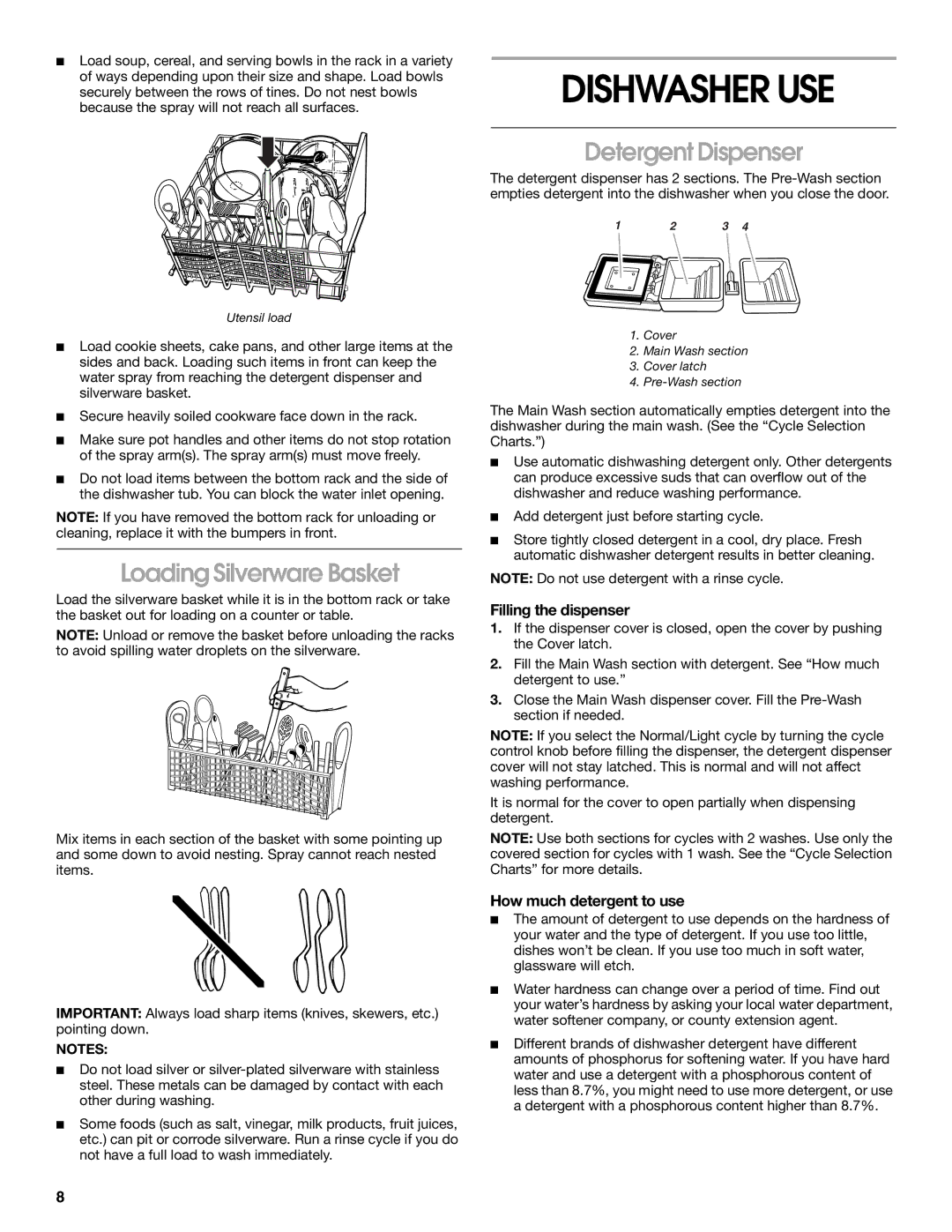
■Load soup, cereal, and serving bowls in the rack in a variety of ways depending upon their size and shape. Load bowls securely between the rows of tines. Do not nest bowls because the spray will not reach all surfaces.
Utensil load
■Load cookie sheets, cake pans, and other large items at the sides and back. Loading such items in front can keep the water spray from reaching the detergent dispenser and silverware basket.
■Secure heavily soiled cookware face down in the rack.
■Make sure pot handles and other items do not stop rotation of the spray arm(s). The spray arm(s) must move freely.
■Do not load items between the bottom rack and the side of the dishwasher tub. You can block the water inlet opening.
NOTE: If you have removed the bottom rack for unloading or cleaning, replace it with the bumpers in front.
Loading Silverware Basket
Load the silverware basket while it is in the bottom rack or take the basket out for loading on a counter or table.
NOTE: Unload or remove the basket before unloading the racks to avoid spilling water droplets on the silverware.
Mix items in each section of the basket with some pointing up and some down to avoid nesting. Spray cannot reach nested items.
IMPORTANT: Always load sharp items (knives, skewers, etc.) pointing down.
NOTES:
■Do not load silver or
■Some foods (such as salt, vinegar, milk products, fruit juices, etc.) can pit or corrode silverware. Run a rinse cycle if you do not have a full load to wash immediately.
DISHWASHER USE
Detergent Dispenser
The detergent dispenser has 2 sections. The
1 | 2 | 3 | 4 |
1.Cover
2.Main Wash section
3.Cover latch
4.
The Main Wash section automatically empties detergent into the dishwasher during the main wash. (See the “Cycle Selection Charts.”)
■Use automatic dishwashing detergent only. Other detergents can produce excessive suds that can overflow out of the dishwasher and reduce washing performance.
■Add detergent just before starting cycle.
■Store tightly closed detergent in a cool, dry place. Fresh automatic dishwasher detergent results in better cleaning.
NOTE: Do not use detergent with a rinse cycle.
Filling the dispenser
1.If the dispenser cover is closed, open the cover by pushing the Cover latch.
2.Fill the Main Wash section with detergent. See “How much detergent to use.”
3.Close the Main Wash dispenser cover. Fill the
NOTE: If you select the Normal/Light cycle by turning the cycle control knob before filling the dispenser, the detergent dispenser cover will not stay latched. This is normal and will not affect washing performance.
It is normal for the cover to open partially when dispensing detergent.
NOTE: Use both sections for cycles with 2 washes. Use only the covered section for cycles with 1 wash. See the “Cycle Selection Charts” for more details.
How much detergent to use
■The amount of detergent to use depends on the hardness of your water and the type of detergent. If you use too little, dishes won’t be clean. If you use too much in soft water, glassware will etch.
■Water hardness can change over a period of time. Find out your water’s hardness by asking your local water department, water softener company, or county extension agent.
■Different brands of dishwasher detergent have different amounts of phosphorus for softening water. If you have hard water and use a detergent with a phosphorous content of less than 8.7%, you might need to use more detergent, or use a detergent with a phosphorous content higher than 8.7%.
8
